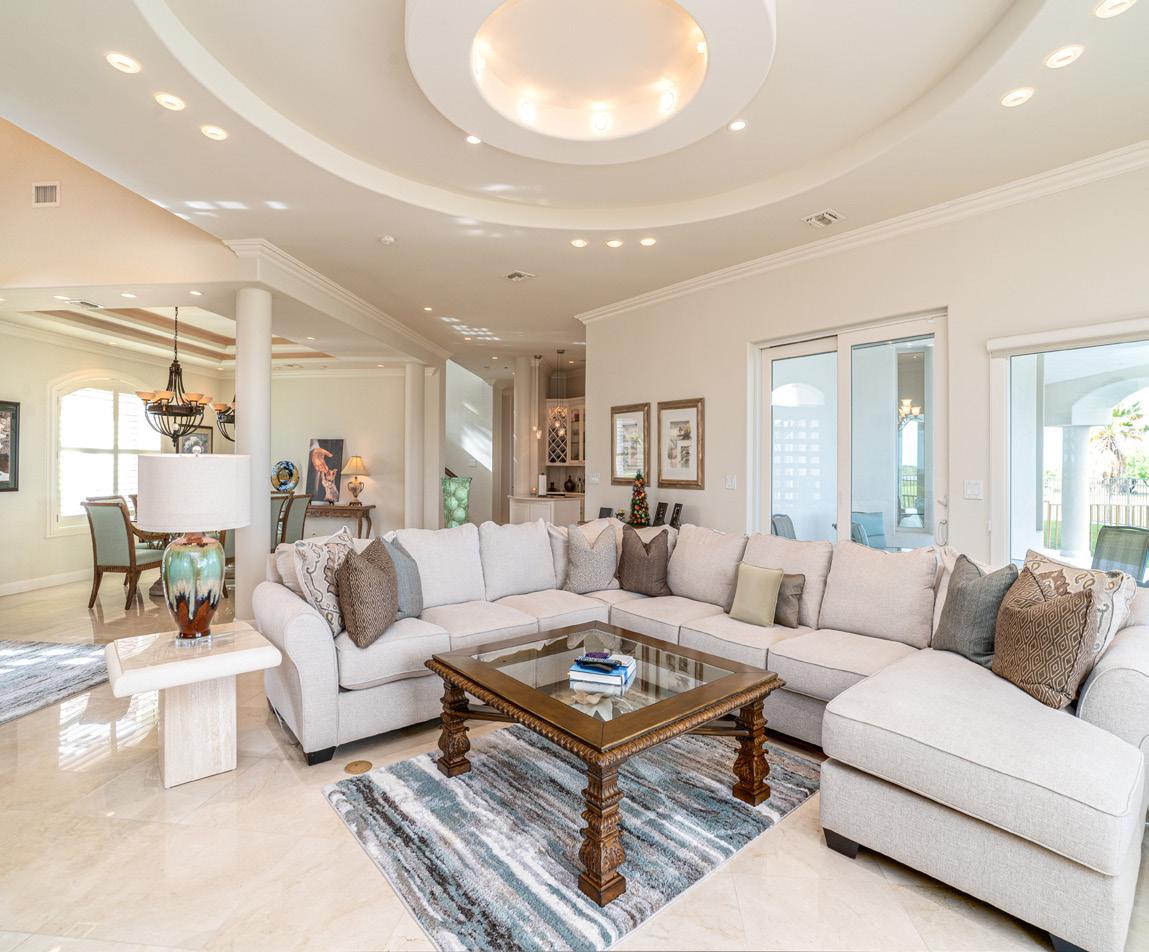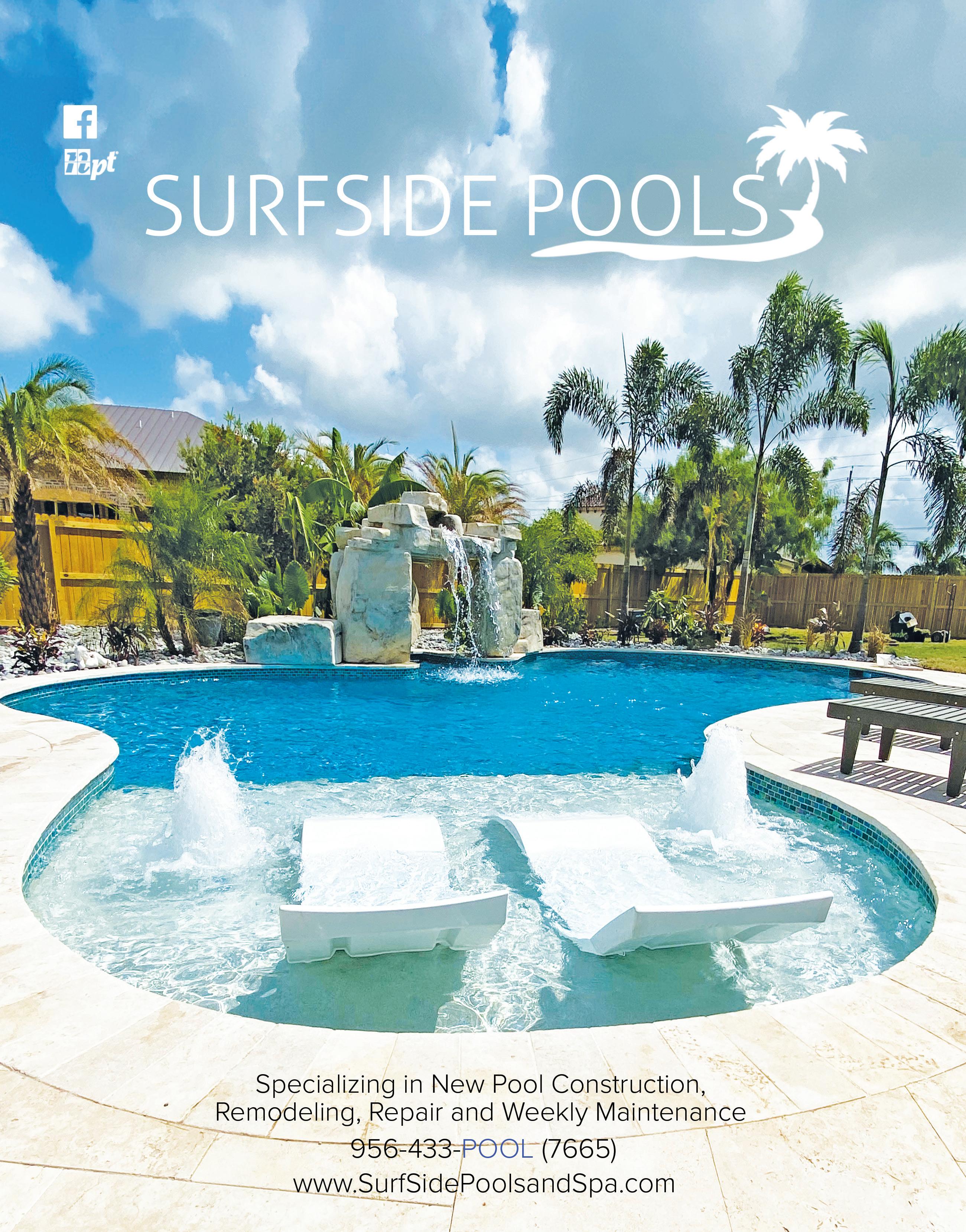

You can dream it. Together we can do it.
Your home customization experience should lead to the creation of your unique vision, but it should also be a pleasant and fulfilling process along the way. Our McAllen showroom lets you experience the bath and kitchen brands we love, while our expert consultants provide the right amount of guidance at every step.


Visit one of our showrooms and discover all the ways Reece. Works for you.

Scan
Temporary Address: 1101 N 23rd St, McAllen, TX 78501
New McAllen showroom coming soon in spring 2023!

Extensive Selection of Quartz
Extensive Selection of Quartz























Extensive Selection of













is
Publisher Eddie Reyes
Editor
Lynn Walker Hoverson
Graphic Design



John Jacob Reyes
Writers
Lynn Walker Hoverson
Eddie Reyes
Graham Wood
Jeremy Miller
Photographers
Anthony Medina
Grey Cox
John Jacob Reyes
All



Spring 2023






OFFERED AT: $1,400,000
MLS: 96710
Beautiful and Serene
30 Laguna Madre, Laguna Vista, TX


INQUIRIES
Veronica Pinkerton: 956.572.0576 veronicarosepink@gmail.com


1700 Padre Blvd., South Padre Island, TX 78597
For more photos and information visit realestate.oledecor.com
Luxury & Privacy await at this impressive estate located on the 4th hole of the SPI Golf Community. Boasting expansive views of the Laguna Madre Bay, Holly Beach and the South Padre Island skyline. This custom built ICF construction offers an open floor plan with 5 bedrooms and 4 1/2 baths that is located on one of the most premier locations in this private gated community. Enjoy amazing sunrises and beautiful birding activity from the comfort of your backyard. Upgrades for this custom home include a drill shaft foundation, concrete stucco retaining wall, imported marble tile floors, granite countertops, elevator, water softener, 48KW generator, high impact hurricane windows, hurricane shutters, stainless steel appliances and much more.



A Must See Home

9 Old Orchard Road, McAllen, TX





Commissioned by the original owners, 9 Old Orchard Road was exclusively designed by acclaimed Colorado architect James Hyatt. With unmistakable architectural style, luxurious finishes & a complete understanding of the land, the home sits with its massive Cantera stone entry and façade facing North and maximizes the distinct dimensions of the almost 3-acre lot. Well known from coast to coast, Mr. Hyatt’s clientele includes a list of scions of industry, banking and celebrity – including one of the Kardashian estates in Calabasas. Located just South of The McAllen Country Club, this spectacular estate is truly a one of kind masterpiece.

T H I N K B I G





B I G G E R L O A N S





The Gelman Stained Glass Museum
 Written by Lynn Walker Hoverson
Photographed by Anthony Medina
Written by Lynn Walker Hoverson
Photographed by Anthony Medina
During the 15 years that Olé Decor magazine has been publishing about construction, real estate, architecture and art, there has never been an article included that featured a museum. Until now, there had not been any new local museums built in the Rio Grande Valley of South Texas. So, in this issue we are especially happy to shine many lights on the recently completed Gelman Stained Glass Museum. It is located in San Juan, Texas, and officially opened its doors to visitors on December 1st, 2021. Most of the information details for this writing are derived from interviews by Olé Decor Staff of the museum’s Director, Miriam Cepeda, and the museum’s eponymous grantor of the stained glass collection, Dr. Lawrence Gelman.
This is only a small part of the story of the Gelman Stained Glass Museum and Dr. Gelman’s adventures in The World of Stained Glass.
Art Endures
Beauty inspires. When grand architecture wraps its strong arms around beautiful art, lifts it up and places it into a unique, “Essence-of-Cathedral” styled home, the effect is magnificent; such is the case of the remarkable Gelman Stained Glass Museum.

From a Flying Drone’s Viewpoint
The museum’s Cruciform Architecture appears to be a modernized version of early European cathedrals; but this building is a museum, not a cathedral. However, according to the museum’s Director, it IS the only museum in the world which was constructed using the cross shape for its architectural floor plan.
 Dr. Lawrence Gelman
Miriam Cepeda
Dr. Lawrence Gelman
Miriam Cepeda
Cathedral or Museum

Marc Chagall (1887 - 1985) was a famous painter and stained glass artist. He has been described as an artist who pushed the boundaries of stained glass with his painterly abstractions. He also did hands-on work on his own stained glass.
Chagall once said, “A cathedral should not be a museum for artworks”. Cathedral construction is not your typical architectural practice in today’s fast-paced world and the skills required are another lost art. Let’s appreciate the choices that must have been required in order to find the right, aesthetically-pleasing balance for the museum’s architecture.
The Director of Gelman Museum of Stained Glass


Within the first few minutes of her interview, the museum’s Director emphasized that the Gelman Museum is the most comprehensive and largest stained glass museum in the United States of America. She explained that the stained glass artworks at the museum are all masterpieces by master artists within the stained glass industry. Most of the windows of the collection displayed in the museum were produced during the height of stained glass’s development and popularity. (Perhaps you have heard of some of the glass artisans, such as Tiffany Studios.) Even an initial, brief, first glance at the fine details of the faces and incredibly varied and intenselycolored illuminated images brings joyful astonishment about the ultimate level of their artistry and craftsmanship
J. & R. Lamb Studios is one of the manufacturers of some of the museum’s stained glass collection. Originally, this company began producing stained glass works in the late 19th century at a location in New York. The J. & R. Lamb company continued thereafter and is still in the stained glass business, but they are now located in New Jersey. Twenty years ago, Dr. Gelman decided to display a handful of some of his windows at the International Museum of Art (IMAS) in McAllen, Texas. At that time, the show was considered IMAS’s most popular exhibit. After 2 years on display, the museum decided to go in another direction and closed the exhibit and returned Dr. Gelman’s loaned collection. It was then the idea emerged to reinstall this collection, plus another 160 windows for the public to enjoy, but within a special dedicated setting, unlike any other museum.
Local Stain Glass artist and owner of Casa Del Vitral Juan Carlos Castillo was instrumental in refurbishing many of the pieces that now comprise the windows of the Museum. See page 11 for artist’s information
ALL the stained windows on display at the Gelman Museum

are from churches and cathedrals located in the U.S. —mostly in the northeastern area of the country; however, there are some European pieces of stained glass on display there which are still being researched for their exact provenance. Following the trail of ownership back through time to original purchases and manufacturers’ location is time-consuming and arduous, but this ongoing process continues at the museum. In the four years that Miriam Cepeda has been with the museum, she has been a big part of this work. When she first arrived she was instrumental in ensuring the desired installation order of the windows was achieved, based on the artworks’ production dates and within a group’s narration chronology. At one point attaining that goal necessitated windows being moved and walls being torn down and restructured!
Illumination of the Glass Collection
To quote the museum’s director regarding their unique and special lighting method for the stained glass: “It’s said that you can’t imitate God, but in the case of our stained glass illumination method, we’ve come pretty close.” Rather than a spotlight effect, the Museum’s illumination uses full spectrum lighting from effective angles. The museum’s construction also required a great deal of perseverance. Working with an eclectic art collector, dedicated to his dream of opening a one-of-a-kind museum to the public, attention to detail was given to every aspect of the construction—possibly frustrating contractors and subcontractors Dr. Gelman’s vision—until after completion of this project. Thankfully, Alonzo Cantu from Cantu Construction, a friend of Dr. Gelman’s and the General Contractor of this project, would repeatedly tell his team, “Do what Dr. Gelman wants.” So, they did— implementing various “change orders” throughout the span of 5 years of construction. Mr. Cantu has stated, “The museum was well worth the wait.”
Mr. Cantu brought to our attention this quote from Elisabeth Kübler-Ross: “People are like stainedglass windows. They sparkle and shine when the sun is out, but when the darkness sets in, their true beauty is revealed only if there is a light from within.” Five years passed from the time ground was broken for beginning the project to the building’s completion. As any visitor can see in the fine carpentry, carving and masonry, a very shiny success it is! At one point in the process, when woodcarving had been the main interior labor for a while, the whole place was filled with a giant cloud of fine sawdust.
Changes of materials’ selection were made along the path to this success. Originally, an impractical idea was considered for accenting the windows; however, hand- carved red oak panels were selected instead. Most of the wood was purchased from Texas Wood Supply located in Donna, Texas. The floor materials were sourced from suppliers in San Antonio, Texas. As you can see in the photographs those surfaces are now so highly polished that you can almost see full, double stained glass imagery within the mirrored reflection. Attention to detail has been given to every aspect of the museum, inside and out. There were, of course, some additional problems, as is the way with construction—not to mention, the recent winter storm, hurricanes and COVID19—but those events resulted in more of the interesting kind of tales that Dr. Gelman could probably use to write a book. (I imagine he could title it: My Stained Glass Safari. If he ever chose to do so, I would certainly buy a copy for myself.)
Dr. Lawrence Gelman
Dr. Gelman proved to us what a good story teller he is during his interview, as he generously and humbly shared some of the stained glass-related happenings he has lived through— from the time he first had stained glass windows offered to him as part of the first house he and his wife built and purchased in 1987 in the Rio Grande Valley — to one of the most recent providential discoveries of an excellent glass artisan who turned out to be a local. Prior to finding Mr. Juan Carlos Castillo, Dr. Gelman had searched many other areas of the U.S. for someone skilled in the almost-lost art of stained glass restoration.
Mr. Castillo has worked on restorations of some of Dr. Gelman’s other windows that are assigned to the location above the museum entry doors. Those sections have varied thicknesses in the glass and require glass pieces being produced in the glass kiln at Mr. Castillo’s fully equipped glass studio. “We are ALWAYS working on stained glass!”, said Dr. Gelman. It is fortunate that Dr. Gelman found this artisan and he has now been relying on his skills to continue with what became something akin to an invisible thread, making a network in Dr. Gelman’s life.

A Tiffany Appears
In the years following his becoming a first-time stained glass owner, Dr. Gelman had grown curious and inquisitive about the differences of quality between the modern stained glass and the obviously, more intenselycolored stained glass works which he had seen in both print photos and digital images— such as some of the magnificent Tiffany windows. After seeing the beautiful images of them, he was willing to buy Tiffany windows, but they remained obscured from him— hidden and nowhere to be found. People told him that Tiffany was just not available; undeterred, he didn’t give up.
As time and life moved on, he frequently searched the Internet—on the hunt for fine, original Tiffany stained glass windows. Eventually he happened across an advertisement that offered authentic Tiffany. So, he called the California number from this ad and talked to the man who answered. Dr. Gelman asked him directly about how was it that he had Tiffany windows for sale when no one else did. Intrigued and trusting just enough, the conversation resulted in a trip for Dr. Gelman to Los Angeles and Malibu, California. Finally, at the seller’s location behind his main house and up a flight of stairs, Dr. Gelman and the “possible Tiffany” owner walked towards the panels that were covered in dusty, aged blankets and leaned up against the wall of the dimly lit storage area. The authenticity was obvious to Dr. Gelman so he negotiated and made the purchase.

A MORE EXPERIENCED EYE
Another time, Dr. Gelman went to look at some stained glass windows to possibly buy. The owner claimed that they were definitely all by Tiffany and said that an assessment had been made by a specialist from Corning Glass who concurred with the owner. Due to his past experiences of seeing countless pieces of stained glass he had personally examined, Dr. Gelman could not agree. After a detailed conference call with The Corning Glass company, the final assessment was made. Dr. Gelman was correct. Stained glass does not presently enjoy the level of popularity that it rightfully claimed in eras of the past, especially during the late 1800s and early 1900s. Now—over a hundred years later, these choice specimens of artworks have been discovered on Dr. Gelman’s path. What began almost thirty years ago as a minor hobby of Dr. Gelman’s grew and became a passion, resulting in Dr. Gelman procuring the largest collection of antique stained glass windows in the United States.
He has worked closely with four major art brokers in the stained-glass world such as Donald Samick from J. & R. Lamb Studios, Don Riggott, Adrian Hamers, and Christie’s of New York. Antique stained glass windows that once were a part of buildings that belonged to parishes— were for one reason or another— removed from their original locations and eventually, made their journeys to South Texas. Various cost and risk factors need to be taken into account when discussing antique stained glass windows, such as the price of the window itself, the disassembly, transportation, restoration, and new installation. That being said, the prime focus of the construction of this museum facility, as with cathedrals, resonated solely around the windows. The windows determined the size of the building as well as the aesthetics of the building to replicate a cathedral. Dr. Gelman determined the new destination for such masterpieces to be displayed should resonate with their original intended locations. He succeeded.
Much like gems, these windows are precious. They are truly priceless. In fact, NONE of the amazing, beautiful windows at the Gelman Museum are for sale. As a unified collection put on luminous display for a nonprofit foundation, there are many projected costs for the future which will be required to maintain and hold the museum. We hope you will visit and experience the joy and luminosity of the Gelman Stained Glass Museum.



MARCH 31 - APRIL 2 McAllen Convention Center

One place. One weekend. All your projects solved.


Save time with everything for your home & garden under one roof. Save money with show-only discounts. Have fun with activities for the whole family and so much more! rgvhomeshow.com SPONSORED BY:


A BURGEONING PORT ISABEL ARTIST
Written by Lynn Walker Hoverson
Let’s give credit to talent where credit is due! If you have been enjoying the beautiful pages of past issues of Olé Decor magazine for the past four years, you have had a sample taste of the artistic talent of John Jacob Reyes.
As production manager of Olé Decor magazine, John’s trained artistry is the source of the well-designed pages appearing with a sleek, flowing layout for your viewing pleasure.

As office manager of Olé Decor, John has many different type of tasks to fulfill and that has expanded to include the production of the fifteen-year-running, The Real Estate Source, another part of the Reyes brothers’ family publishing business. Putting together magazines is much like conducting an orchestra. Just ask John’s brother, Eddie! John has consistently applied his digital skills towards churning out finished products, otherwise seen as pages in the publishing business.
He graduated from High School in 2011 in Port Isabel and then went to the university of TSTC (Texas State Technical College) in Harlingen. In 2018 John graduated with honor and distinction with a graphic Design degree from TSTC.

When asked if he has been interested in art for a long time, he said, “ Yes, always… but I have barely been able to pursue it after college ”.





Lately, he has been finding the time to follow through with his personal journey down the Artistic Path by doing more drawing and painting at home. He has used hIs graphic design skills to produce some colorful designs that he sells on stickers and keychains in South Padre Island local markets. Other activities that John enjoys in his life when he is not working in the publishing realm are: going to concerts with friends, playing video games and watching movies and trying out different kinds of food with my fiancé.



“Colorful and chaotic” are the words thirty-year-old John uses to self-describe his work. See for yourself on these pages about him.








Endless Summer
Written By Graham Wood Photographed By Greg CoxThis thatched riverside holiday home in the surfer’s mecca of St Francis Bay in South Africa puts a series of simple barn-like buildings in the service of the ultimate relaxing family holiday experience

There is a term that almost every surfer knows, which was coined in the South African coastal town of Cape St Francis: “The perfect wave”. The classic 1966 surf film The Endless Summer followed two American surfers around the world in their quest to find every surfer’s holy grail. They found it in Cape St Francis, peeling away endlessly along a deserted strip of paradisiacal beach in the Eastern Cape. A voice over by awestruck narrator and filmmaker Bruce Brown intones over the 16mm hand-held camera footage: “I couldn’t help but think of the hundreds of years these waves must have been breaking here. But until this day, no one had ever ridden one.”
Since then, Cape St Francis’s waves haven’t been neglected, and the town has grown to become more than just a surf destination, but it still retains that mythic charm. South African-born Fiona Ferguson has the happiest memories of family holidays spent in the adjoining marina, St Francis Bay, on the Kromme River, as a child. Its idyllic setting with beautiful canals and wide river seems to represent nature at its best.
The gravel entrance courtyard from the street-facing side of the house creates a sense of arrival. The low curved white wall and thatch roofs are reminiscent of traditional Cape Dutch farm architecture. “I tried to reinforce that by referencing certain traditional elements, but reinterpreting them in a contemporary manner. The low werf muur with its wooden gate surrounds the entrance courtyard with its welcoming scale,” says architect Bert Pepler.

The bathrooms are an interesting mix of modern and traditional design features, predominantly in white and brass, but the overriding characteristic is simplicity. Contemporary hexagonal tiles contrast with the traditional basins. The sense of luxury comes from the light and space.” Each bathroom opens onto a private, planted courtyard with an outdoor shower. “Besides the vanity mirrors, for the main bathroom we also designed an over-sized round mirror,” says Bert. “When you enter the bathroom, it reflects the planting in the courtyard and makes the space feel bigger and lighter.” From the courtyard of the main en suite bathroom, a door opens onto the garden and a path leads down to the beach, which makes it possible to come directly from the river and to shower before entering the house. The round tray table is a converted Ethiopian tray table, available from Toguna.

Looking over the swimming pool, the views of the river from the outside dining area are spectacular: a good example of the “connection from the land to the water” that Bert speaks of. The dune forest vegetation from next door has been reinforced and extended so that it spills over into this garden and creates a borrowed view. The swimming pool features long, low, gently curving white walls. “We wanted the pool to feel like an old reservoir, but in addition to relate to the curves of the house,” says Bert. Even the pool functions as an outdoor seating area, with a built-in seat at one end where one can lounge while interacting with others, whether they’re spread across the pool, on the deck or under the thatch covered terrace. The poolside furniture includes woven poolside ottomans by Fibre Designs and Instomi Sun Loungers by Meyer Von Wielligh. The furniture on the deck includes moulded plastic chairs and a coffee table from the Stones Collection by Vondom.

The main living area is open and relaxed. “The beams and the ceilings are all poplar, with a light grey wash. When you’re inside the house, the roof is reminiscent of an inverted boat hull,” says Bert. He points out that the roof is a complex piece of engineering, which necessitated steel tie rods, some of which are used to mount lights. The large, barn-like living and dining pavilion connects with the outside courtyards via the sliding glass doors, while the sliding timber shutters help contain the space and make it feel solid and secure when called for. The traditional solid gable is replaced by the light, slatted, aluminium screens, which allow sunlight to filter through during the day, but still provide a sense of containment to the living areas behind. At night, the illuminated interior renders the gables transparent, showcasing the timber roof structure inside.
Above the dining room table, by Egg Design, the Large Cork Pendant lights are by Laurie Wiid van Heerden of Wiid Design. “The space was so big it needed something to ground it,” say Carla and AJ. In the lounge, the Zio lounge Chair, the Cocktail Chair, the Cloud Sofa, all by Marcel Wanders, and The Pig Table by Front, are from Moooi. The coffee table is from Minotti’s Sullivan family of coffee tables designed by Rodolfo Dordon. The Gyro SE turntable is by Michell Engineering, available at The Listening Room. The Flokati rug was brought in from Greece to introduce a relaxed, unstructured element to the room. The Big Sweat standing lamp is by Dokter and Misses. Architect Bert Pepler designed the brass fireplace with beautiful dovetail joint details. Brass has also been used for the ironmongery and taps throughout the house, contrasting luxuriously with the neutral wood surfaces.

The kitchen features the same light oak that has been used for interior finishes throughout the house, while the taps and handles are brass. “I really wanted to keep everything light, consistently using a limited pallet of materials to create a cohesive whole,” says Bert. The neutral kitchen forms the backdrop for the island unit. “The central island unit is purple, and with its unsealed brass top is the focus of the room,” says Bert. “When the drawers are opened, the orange interior provides an element of surprise and a sense of fun.” The industrial-inspired V19R Dining Stools by Nuevo add a hint of a steam punk aesthetic to the kitchen. The chandelier, salvaged from a previous house, is a tongue-in-cheek touch “in defiance of all the other good taste” as Fiona puts it.

The dining area includes a long bespoke dining table by Egg Design. The Large Cork Pendant lights are by Laurie Wiid van Heerden of Wiid Design. The dining chairs are elegant but durable Kristalia Elephant Chairs with wooden bases. “The broad, oak plank flooring is saw-cut and creates a relaxed feeling, reminiscent of a weathered barn,” says Bert. With the doors and screens aside, you have a strong sense in this room of how the interiors connect with the courtyards. “All the doors and shutters slide away into cavities” says Bert, “On a beautiful still day, when all the doors are open, the structures feel like a series of thatched pavilions allowing the seamless free flow of movement from inside to out.” The long, barn-shaped forms telescope the eye towards the views of the river. “Although I wanted a sense of lightness,” says Bert, “I wanted the structure to feel robust and organic.” The solid over-sized Bluegum columns and the unevenly planed roof beams reinforce this concept.

The roof continues beyond the end of the living and dining areas to create a sheltered outdoor seating area. On the left, the sliding shutters open from the TV lounge allowing access to this space. This is an example of how the form of the house provides wind protection. “The main bedroom wing shelters the outdoor space from the westerly wind providing a perfectly protected outdoor room for entertaining,” says Bert. The outdoor sofas, which look out over the garden, are by Meyer Von Wielligh. “We did the Malawi chairs in great colours,” says Carla. The Mood Coffee table with stone grey and white trespa top is from Manutti. The Soma planter by Laurie Wiid van Heerden of Wiid Design combines lightweight moulded reinforced concrete with timber. The Langazela cushions are handcrafted for Africa!Ignite from recycled corn bags. The outdoor rug is from The Verandah Collection by Fibre Designs.

Two of the bedrooms have loft spaces where friends and cousins can easily be packed in. The window seats double as beds for additional sleeping space. Fiona says the boys love sleeping up in the lofts, especially when they have friends over. Bert designed the built-in bed unit with its retro reference as well as the honeycomb shelves above the kitchenette in the outside guest bedroom. The lamps are wall-mounted Type 75 Mini lamps by Artemide. In corner, the Slump Chair is by Egg Design. The throw is by Mungo, and the cushion fabric is Christopher Farr.





Miniature Pools Small Spaces
 Written By Jeremy Miller
Written By Jeremy Miller
Inground Pools for Small Backyards

Summer is just around the corner, and it’s the perfect time to start thinking about installing a small in-ground swimming pool. While many homeowners dream about having their own personal oasis to share with family and friends, those with smaller backyards may feel as though it’s an unattainable dream. If this has been a concern of yours, we’ve got great news: no matter how compact your space is, there’s a way for you to enjoy some fun in the sun and water. The flexible designs, shapes, and sizes of a fiberglass or vinyl liner pool make it possible for you to design a gorgeous centerpiece for your property.
The average size inground swimming pool is larger than 600 square feet. A small, or ‘boutique’ swimming pool is typically considered to be one that is 600 square feet or less. Depending on the shape, size, and design, a small inground swimming pool could still be used for aquatic exercise, as well as purely for recreation. While waterfalls and other water features may be incorporated into a smaller-scale swimming area, diving is not recommended. A small pool will usually be no more than 5 or 6 feet deep. This ensures that homeowners get the most usable space out of their pools.
- This little oasis only measures 12 x 24 feet with a Silver 6 x 12 inch travertine coping. Silver Versailles pattern travertine was used for the deck & Npt stonescapes Cameroon black plaster. pg. 48

How Much Backyard Space Do You Need For A Small Pool?
Many homeowners want to know, “Can you put an inground pool in a small backyard?” The answer is absolutely yes! As you might be surprised to learn, as little as 1,200 square feet of backyard space provides enough room to install a stunning pool. Not only is it possible to install a pool in a small yard, but with today’s innovative technology, there are more design options than ever before to choose from.

What Shape Is Best For a Small Swimming Pool?
Because every backyard is different, there’s no black and white answer to what pool shape is best for a small yard. While some may dislike the fact that curvier kidneyshaped pools lose some water space, others love that this allows for more decking space for lounge chairs and patio furniture. Working with a design specialist to assess your property and demands will enable you to come to the right solution for your home. However, there are some fiberglass pool shapes and designs that easily lend to being used in a small backyard.
Small Backyard Pool Designs

Limited space doesn’t have to limit your design options. From classic to modern, there’s a wide range of looks and styles available for small inground pools. But how should you choose the best style to meet your needs and specifications? For example, what style is best if you want to swim laps?

What Considerations Should Be Made For My Pool?
Before planning the layout for your swimming pool, it’s important to discuss your preferences with your local pool builder. Be sure to evaluate how much time you and your family anticipate spending in and around the pool, and how important it is that you have a grassy area within your yard where the kids are able to run and kick a soccer ball around. These types of things can help your designer to determine how the swimming pool should be laid out, what size restrictions there may be, and how to best optimize your landscape so that it’s tailor-fitted to suit your every whim.


What’s The Best Type Of Pool For A Small Yard?
Having the ability to play around with different shapes is crucial to maximizing your space for a small swimming pool. A fiberglass pool is a great option because there are so many different shape, size and design combinations available. Even if you’ve got an oddly shaped backyard, you can make it work! Fiberglass also enables you to get multiple uses out of your pool. In addition to keeping you cool, you can also add waterfalls, streams, and spillways that allow it to double as an attractive water feature, or even build in a tanning ledge to save more space.





